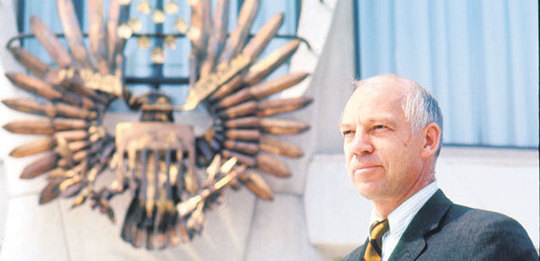IT has proved somewhat ironic that the proposed Ballsbridge location for a US embassy, once described as a
“slum
?, is now one of the most sought after addresses in the city.
The history of the iconic building is being recalled as it marks 50 years in the Southside suburb.
The US Ambassador to Ireland, Kevin O’Malley, opened an exhibition in the Architecture Gallery of the Irish Architectural Archive to celebrate the anniversary, which features copies of original drawings for the building by John Johansen held in the Avery Library, Columbia University, New York, and photographs taken in 1964 by the noted architectural photographer Norman McGrath.
The exhibition, which will run until January next year, recalls how John MacLane Johansen (1916-2012) was retained to design the Dublin embassy in November 1956.
He was appointed professor of architecture at Yale in 1955, but the Dublin embassy ranked as a major commission. Up to that point he had, by his own admission, designed
“only houses
?.
Johansen attributed his selection to his earlier reputation as a classicist, which he further established in drawings for the project which showed the
‘Schokbeton’ precast concrete elements that make up the iconic Dublin embassy façade today.
The project proved controversial from the start, considering Representative John Rooney of Brooklyn publically described the proposed Ballsbridge location as a
“slum
?.
The design went through several stages before the final cylindrical scheme emerged, inspired by ring forts and Martello towers.
But political infighting and budgetary issues delayed the project, and almost derailed it completely. It took the arrival of John F Kennedy in the White House to rescue matters.
Johansen personally showed Kennedy his designs and with Presidential endorsement ground was finally broken in 1962. The building was completed in May 1964. The main contractors were G & T Crampton, with the precast elements coming on barges from Holland. The executive architects were Michael Scott & Partners. The building was opened on May 23, 1964, an occasion Johansen remembered as a
“free whiskey party for some 300 tipsy Dubliners
?.
When it was finally completed, the building was broadly welcomed, with voices as diverse as the Architectural Review, Time Magazine, the Irish Builder, the Irish Times and An Taisce uniting in enthusiasm and praise. Deploying the most advanced concrete technology available, Johansen delivered a career milestone, a distinctive, refined and elegant structure, unabashedly modern, even American, yet respectful of surroundings and location.
As accomplished as any building in the US embassy programme of the 1950s and 1960s, the context has changed due to prevailing security concerns but still remains after 50 years an icon of modern architecture in Dublin.
The Architecture Gallery is open to the public from 10 am to 5 pm, Tuesdays to Fridays.
